Whether you’re an IT technician or an ardent PC gamer, you need to ensure that every part of your computer is up and running efficiently. However, your computer’s task manager can’t give you a full picture of what’s actually happening inside your PC.
Fortunately, the right PC monitoring software can help you out here.
Computer monitoring software can display real-time statistics about various components such as CPU, RAM, GPU, hard drive, etc., to help you detect any hardware malfunctions.
This type of software not only makes it easier to detect hardware issues earlier but also helps you save both time and money.
In this article, we’ll highlight the ten best PC monitoring software platforms along with their key features and pricing. We’ll also tell you what you should look for in such monitoring tools.
Table of Contents
- The 10 best PC monitoring software options
- What is PC monitoring software?
- Data points provided by PC monitoring software tools
- What should you look for in PC monitoring tools?
Let’s dive in.
The 10 best PC monitoring software options
If you want to dive into some of the basics of software that can monitor PCs, jump ahead to learn about what it is, the data points you can find in such software, and how to pick the right kind.
Here are our top 10 picks for computer activity monitoring software.
1. NZXT CAM
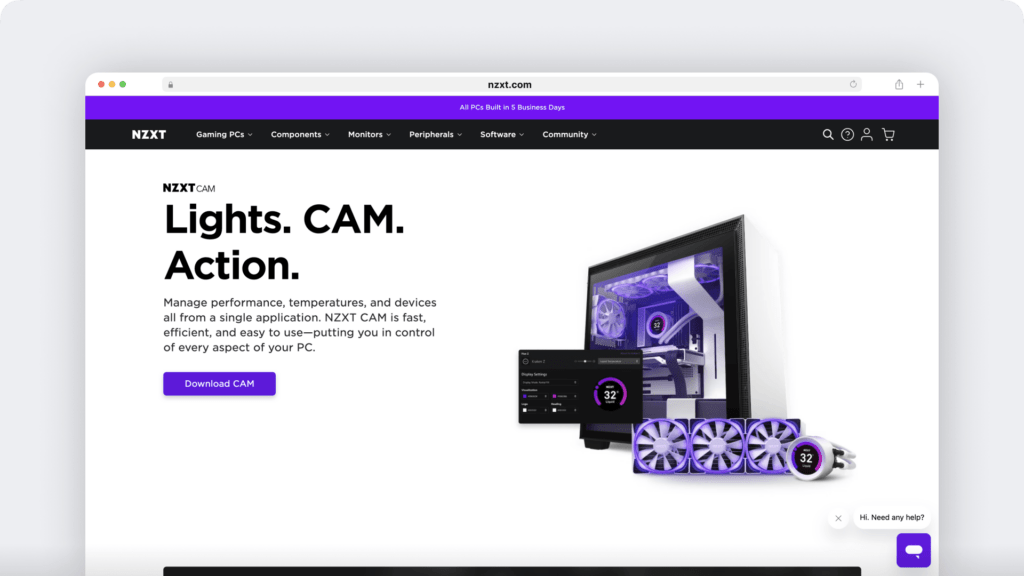
NZXT CAM is one of the best computer monitoring software options for tracking every device component through a single app. It can monitor your fan speed, components’ temperatures and overclock their speeds as well.
Note: Overclocking or increasing a component’s clock rate causes it to perform more operations per second, thereby increasing its performance.
With this hardware tracking software, you can check your computer’s memory usage and set alarms for errors. This app also sends you notifications on your phone to monitor your system on the go.
Key features
- Gives you real-time data on your GPU and CPU temp, memory usage, storage, and network performance.
- Lets you know what applications are active on your computer.
- Tracks your FPS, temperatures, and bandwidth with an in-game overlay.
- Lets you customize the behavior of your fans and lighting for different times of the day.
Pros
- Control RGB lights, CPU cooling devices and fans including NZXT products unsupported by other PC monitoring utilities
- Has basic PC monitoring functionality including CPU and GPU utilization and temperature checks
Cons
- Not open source
- User reports of system stability issues
Pricing
NZXT is a free hardware monitoring tool.
2. MSI Afterburner
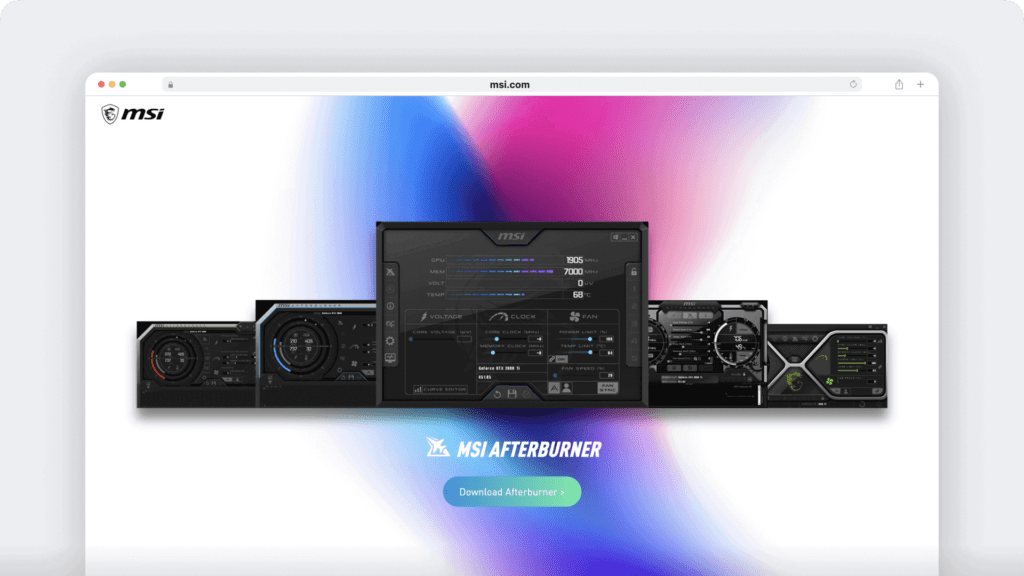
As a gamer, you need to monitor and tweak your graphics card performance to improve your gaming experience.
Fortunately, MSI Afterburner is the perfect performance monitor for any gaming enthusiast.
This monitoring tool lets you monitor your PC activity and gives you complete control of your graphics card. You can monitor your GPU temperature, adjust its clock rate, fan speed, power limits, and more.
Additionally, you don’t need an MSI system to use this tool. This hardware monitor supports other brands as well.
Key features
- Allows you to increase your GPU’s clock speed and voltage.
- Lets you fully customize a predefined fan speed curve to monitor cooling performance.
- The OC Scanner finds the highest stable overclock settings for your card.
- On-screen display gives you real-time information about your system’s performance while gaming.
Pros
- Excellent as a GPU focused PC monitoring utility
- Includes GPU overclocking features
Cons
- User interface is very dated and takes time to learn
- Not intended to be an all-in-one consumer PC monitoring suite, as it lacks RGB control and non-GPU fan control
Pricing
MSI Afterburner is a free graphics card monitoring software.
3. HWiNFO
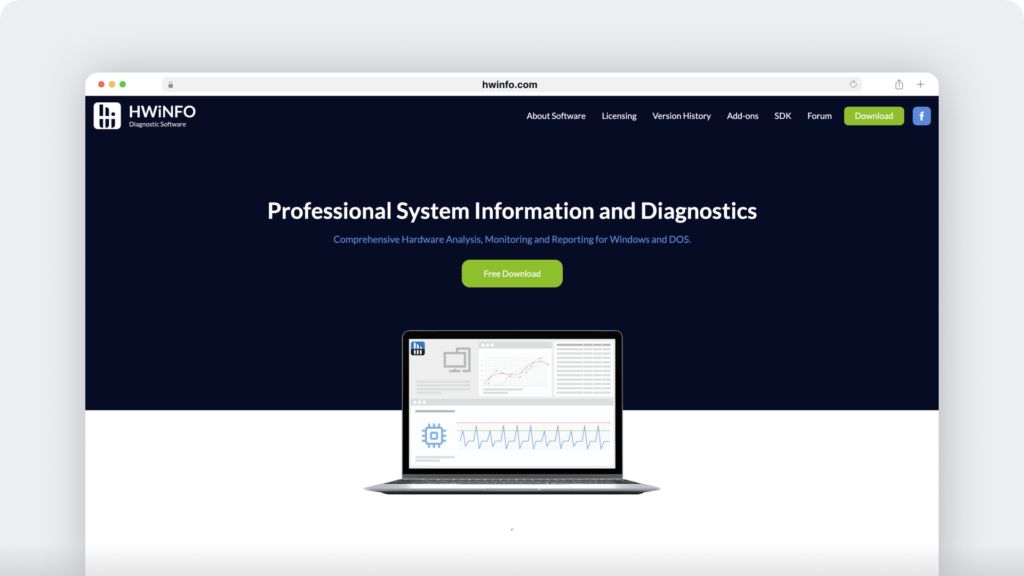
HwiNFO is an all-in-one hardware monitoring tool that you can use on a Microsoft Windows or DOS computer. NASA even used it for monitoring computer system failures in high radiation fields.
This monitoring software can give you in-depth information about your computer’s hardware. This app has a customizable user interface that provides you with real-time updates as well as failure predictions.
Moreover, you can use this PC monitoring tool with other software and third-party extensions to get a comprehensive overview of your computer performance.
Key features
- Offers real-time monitoring of multiple parameters for CPU, GPU, mainboards, drives, and peripherals.
- Displays detailed hardware component specs in a hierarchy.
- Provides multiple reports, status logging, and interfacing options.
- Offers customizable alerts on any monitored metrics.
Pros
- Excellent PC monitoring functionality
- Extremely detailed presentation of current PC component status, including including temperatures, voltages, and fan speeds
Cons
- User interface is excellent for presenting a lot of data, but can be overwhelming and takes time to learn
- Not intended to be an all-in-one consumer pc monitoring suite as it has no RGB control or fan control
Pricing
HWinfo is a free hardware monitoring software.
4. Paessler PRTG Network Monitor
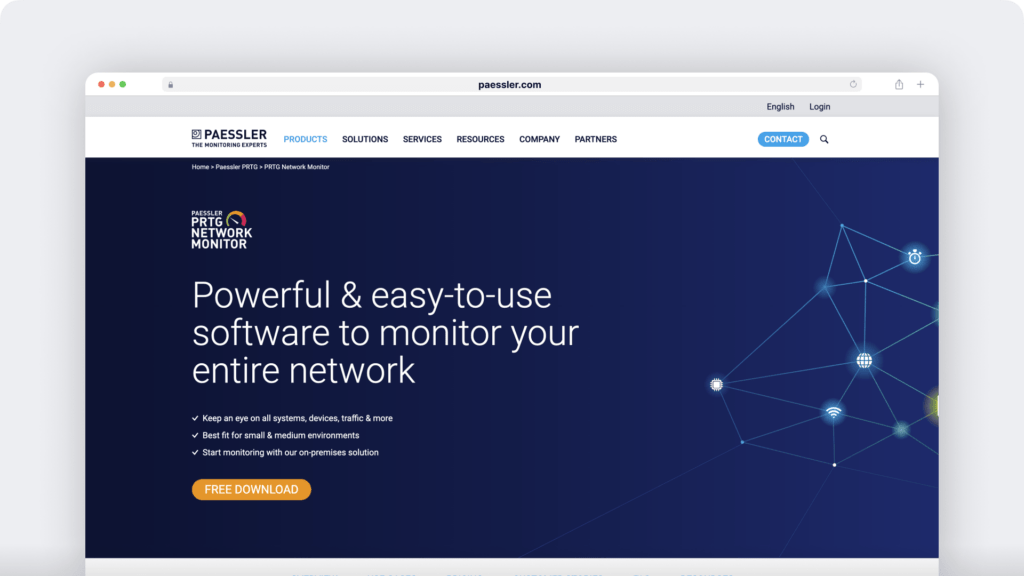
If you have multiple Windows systems on your network and want to monitor employee activity on each computer, you can use the PRTG Network Monitor app.
You can use this tool for effective employee monitoring regarding network availability, traffic, and other components usage. This hardware monitoring app also notifies you via SMS, email, or pager when an outage or hardware failure occurs on any employee computer.
Moreover, this tool has an easy-to-use interface. You can also screenshot and share the data with non-technical employees or customers.
Key features
- Monitors CPUs and memory capacities and alerts you about any issues with loads, temperature, and other failures.
- Alerts you about low disk space and records changes in data.
- Monitors network printers, including cartridge’s ink level and the number of printed pages.
- Monitors environmental settings, such as temperature and humidity inside server rooms.
Pros
- Comprehensive network monitoring including network, systems and applications
- Effective notifications and visualization tools
Cons
- User interface not well designed for consumer use
- Not intended to be an all-in-one consumer PC monitoring suite
Pricing
The paid licenses of this system monitoring tool start at $1899/license.
5. Open Hardware Monitor
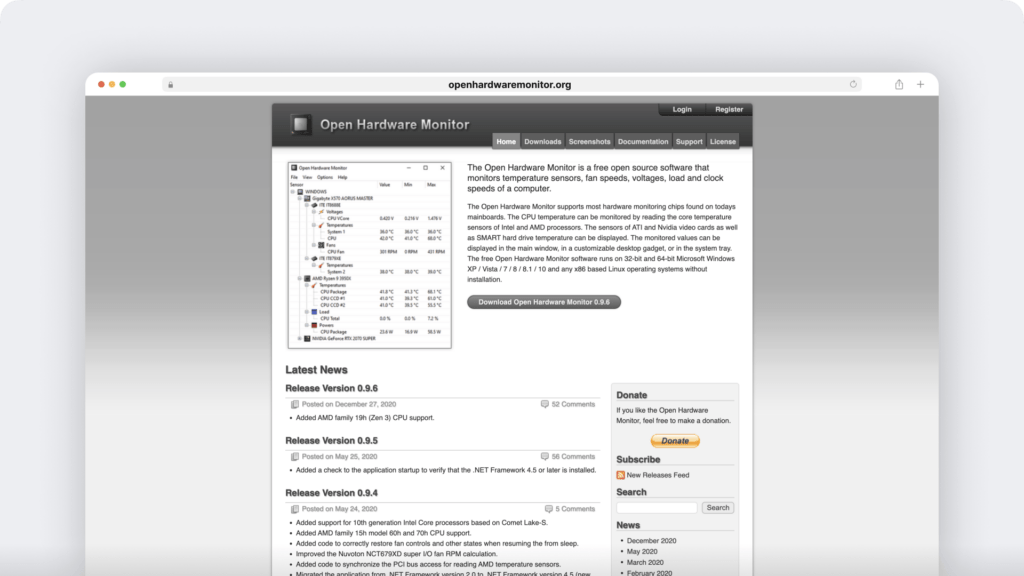
Open Hardware Monitor is open-source software that lets you monitor fan speeds, voltages, and more. It also works as a CPU thermometer and enables you to overclock the components of your computer.
This hardware monitoring software can also read the sensors of ATI and Nvidia graphic cards as well as SMART (Self Monitoring, Analysis, and Reporting Technology) hard drive temperatures.
Key features
- Supports most of the hardware monitoring chips that control the flow of data between different computer components.
- Monitors CPU temperatures by reading core temperature sensors of Intel and AMD processors.
- Can display monitored values via a customizable desktop gadget or in the system tray.
- Supports Windows and Linux operating systems.
Pros
- Good PC monitoring functionality
- More limited sensor tracking may be less overwhelming for new users
Cons
- User interface is extremely dated
- Won’t work as an all-in-one consumer PC monitoring suite
Pricing
Open Hardware Monitor is both free and open source.
6. HWMonitor
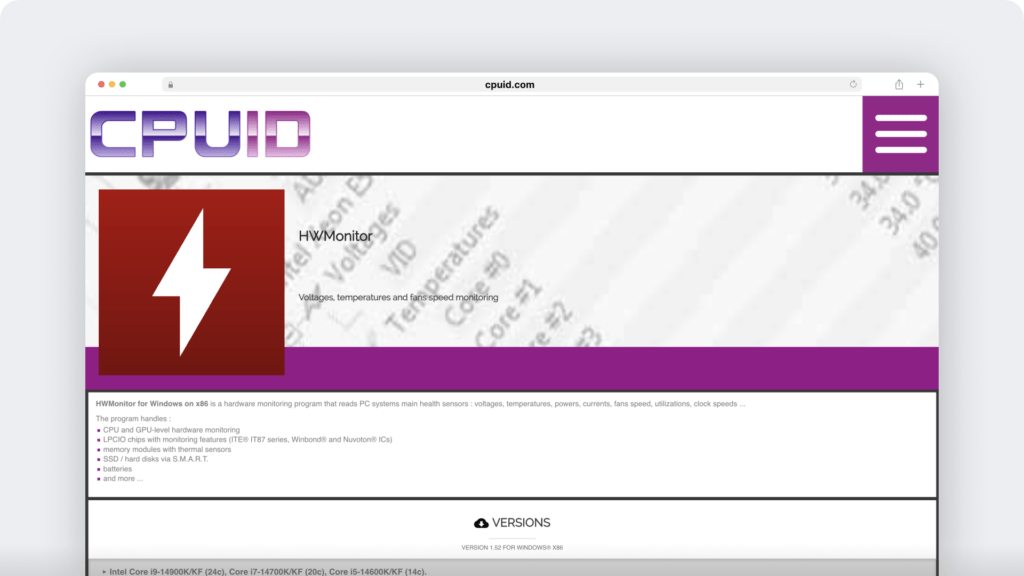
HWMonitor by CPUID is a monitoring software that can provide critical hardware information like voltage, temperature, and fan speeds.
This PC tracking software has a user-friendly user interface. The app displays all the core component data in a single window, which is easy to understand even for non-technical users.
This computer monitoring tool is available for both 32-bit and 64-bit Windows versions and can be installed on Windows 10, XP, Vista, 7, and 8.
Key features
- Reads PC’s main health sensors.
- Displays hard drives temperature via SMART (Self Monitoring, Analysis, and Reporting Technology).
- Reports graphics card temperature.
- Pro version can save monitoring data and generate logging graphs as bitmap files.
Pros
- Good PC monitoring functionality
- More limited sensor tracking has a smaller learning curve
Cons
- User interface is extremely dated
- Won’t work as an all-in-one consumer PC monitoring suite
Pricing
The classic version of this PC monitoring tool is available for free. Paid plans start at €19.95.
7. AIDA64 Extreme
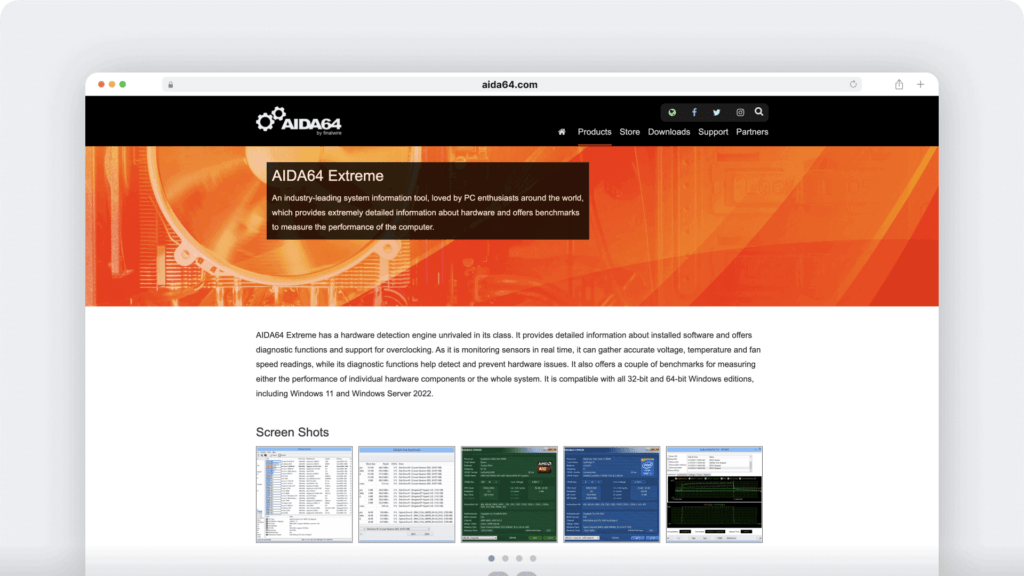
AIDA64 is another industry-leading hardware monitoring app that can provide detailed information about your computer hardware like CPU usage and CPU temp.
You can use this computer monitoring app for overclocking and running other diagnostic functions to detect hardware issues.
It also provides 50+ pages of information on hardware configuration, installed programs, software licenses, security applications, and Windows settings. The AIDA64 Extreme Beta also supports certain Mac computers.
Additionally, this tool provides the benchmarks or standard readings for every computer hardware component. This way, you can compare the performance of your device with those benchmarks.
Key features
- Offers a stress testing module to test the limits of your PC’s components.
- Supports 250+ sensor devices to measure temperatures, voltages, fan speeds, and power draw.
- Includes a hardware detection module with a database of over 230,000 entries.
- The customizable panel includes graphs, gauges, custom images, and dynamic or static texts to display the sensor data.
Pros
- Excellent as a component test and benchmark suite, especially for RAM tests
- Extremely detailed information on installed PC components
Cons
- User interface is very dated
- Not intended as an all-in-one consumer PC monitoring suite
Pricing
This hardware monitoring tool is available for $59.95.
8. AMD Ryzen Master
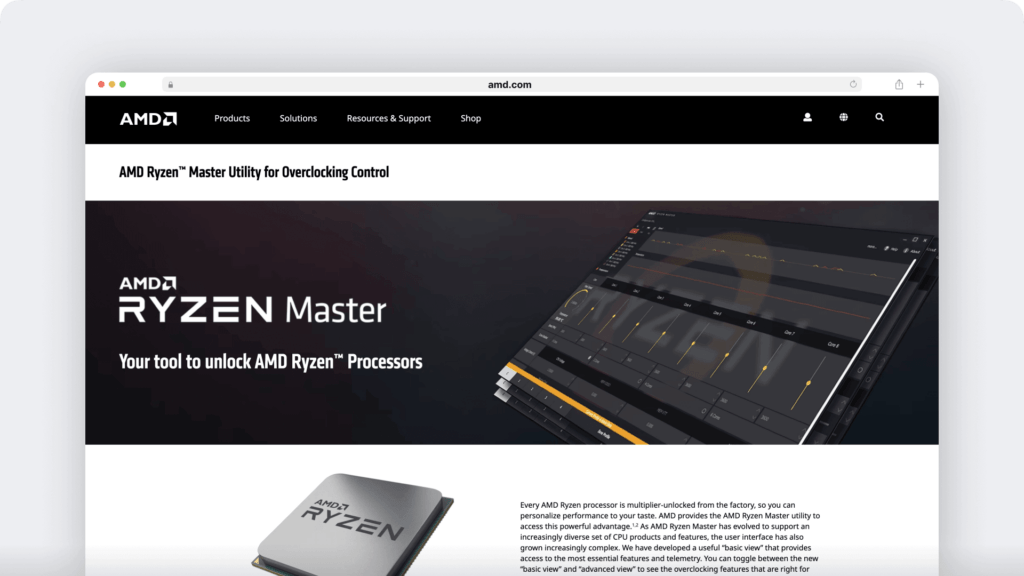
If your computer uses AMD processors and an AMD graphics card, it only makes sense to use an AMD monitoring tool to personalize the performance of these components.
AMD Ryzen Master has been designed to support a diverse range of CPU products and give you real-time control over your system performance. You can use it for overclocking and control voltage settings as well.
This tool also provides two views — Basic and Advanced, to toggle between the essential monitoring features and custom profiles.
Key features
- The basic view lets you automatically overclock your CPU and provides important system parameters like CPU usage, temperature, speed, and voltages.
- The advanced view allows up to four profiles to store custom user-defined configurations for the CPU, graphics card, and RAM.
- Offers real-time monitoring and a histogram of per-core clock rates and temperature.
- Integrated Radeon™ GPU overclocking lets you customize your graphics card performance.
Pros
- AMD focused monitoring and overclocking tool
- User interface is excellent for presenting a lot of data with basic and advanced views for different user skill levels
Cons
- User interface can be overwhelming and takes time to learn
- Not intended to be an all-in-one consumer PC monitoring suite
Pricing
You can download this PC monitoring software for free.
9. SolarWinds server and application monitor
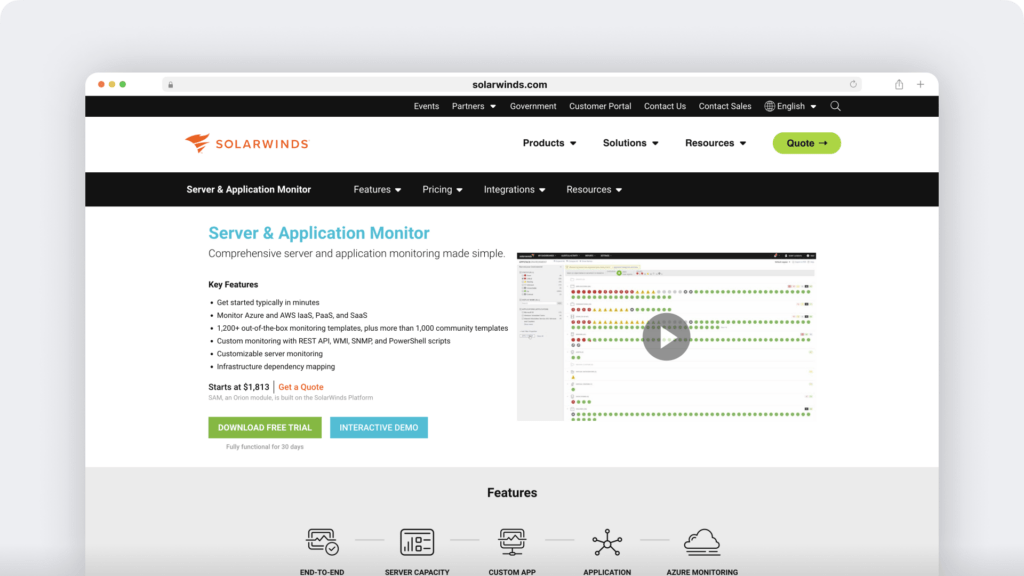
SolarWinds Server and Application Monitor can give you greater insight into your application and server performance issues.
You can run this app on a Windows server to get information about your core component’s performance.
Keeping enterprise networks in mind, this tool was designed to support a wide range of services, programs, and software. This means you can control multi-vendor apps from a single console.
Key features
- Helps you monitor CPU usage, fan speed, server temperature, and power supply.
- Offers 1,200+ application monitoring templates to monitor response time.
- Allows remote monitoring of FTP traffic and user activity to eliminate potential issues.
- Intelligent application monitoring alerts you when health indicators reach critical thresholds.
Pros
- Comprehensive network monitoring including network, systems and applications
- Effective notifications and visualization tools
Cons
- User interface not designed for consumer use
- Not intended to be an all-in-one consumer PC monitoring suite
Pricing
The licensing options of this server and app monitor start at $1,813.
10. SpeedFan
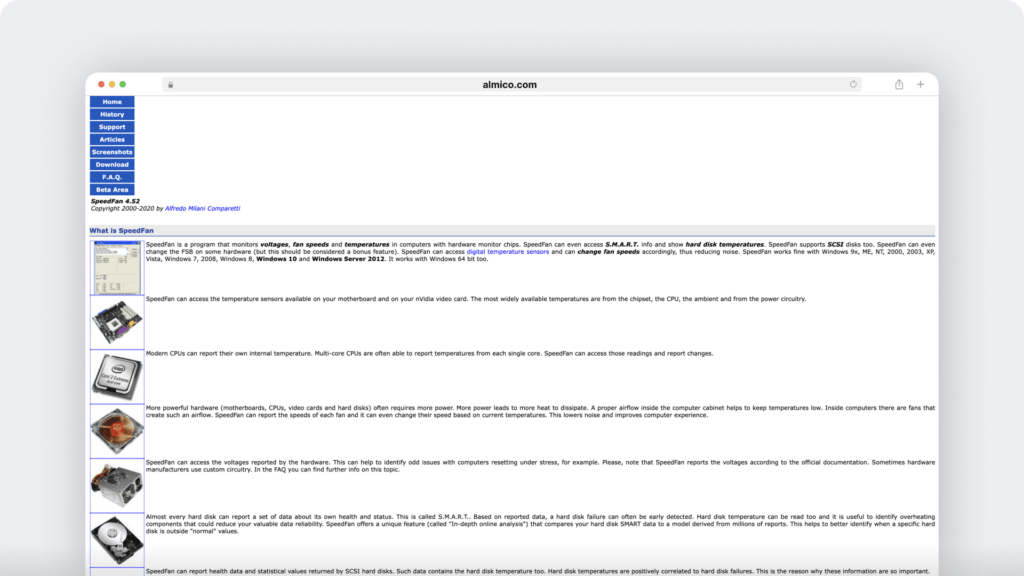
Speedfan is a no-frills computer monitoring tool that lets you oversee your computer’s fan speeds. You can also manually adjust the fan speeds of different components if your computer is prone to overheating.
This app also has a monitoring feature that informs you about the temperatures of your CPU, graphics card, and other peripheral devices.
Moreover, advanced users can use this tool to get customized overheating warnings, SMART system statistics, and power usage of each fan.
Key features
- Shows hard disc temperatures and related information.
- Changes the FSB (front-side-bus) speed on some hardware.
- Has access to digital temperature sensors and changes fan speeds to reduce noise.
- Works well with different Windows versions like Vista, Windows 10, and Windows Server 2012.
Pros
- Good PC monitoring functionality focused on fan speed monitoring and control
- More limited sensor tracking may be less overwhelming for new users
Cons
- User interface is extremely dated
- Not intended to be an all-in-one consumer PC monitoring suite, as it has no RGB control and only basic component monitoring
Pricing
You can download this PC monitoring tool for free.
Now that we have explored the best monitoring tool options, let’s go over some computer monitoring basics.
What is PC monitoring software?
PC monitoring or hardware monitoring software analyzes and reports periodic information it collects from the core components.
The core components of a computer include:
- Motherboard.
- CPU (Central Processing Unit).
- GPU (Graphics Processing Unit or Graphics card).
- RAM (Random Access Memory).
- Storage drives.
The hardware monitoring tool then displays this information in real-time graphs.
Additionally, let’s suppose there’s an unexpected system error in the target device. In that case, your computer monitoring software will notify you about it before it leads to any hardware malfunctions or a complete system crash.
Monitoring software is also crucial for companies who want to conduct remote PC monitoring on their employees’ systems.
Why?
These tools can relay the PC activity or data points of a remote computer via the cloud and let your IT department handle system errors without physically inspecting the employee PC.
Data points provided by PC monitoring software tools
Here are some of the data points that hardware monitoring can provide:
- CPU (Central Processing Unit) Usage: The amount of time a target device uses its CPU for processing instructions of a program or operating system. CPU monitoring can help you identify overactive CPU usage.
- Core temperature: The temperature of a running CPU. Your CPU temperature should remain as low as possible. If not, it could lead to a system crash and permanently damage the processor.
- Fan speed: Computers have fans for actively cooling different components. For optimal use, you need to adjust the fan speed to balance out the noise and performance of your device.
- Voltages: Knowing the power supplied to different computer parts is crucial for computer monitoring as both over and under voltage can impact your server or PC.
- Memory utilization: Along with CPU usage, you also need to monitor excessive cache memory usage as it could decrease system performance.
- Physical disk space: It’s the maximum amount of data a disc or drive can hold. A monitoring tool can give you a heads up about low disc space or a faulty disk by displaying the average response times of your PC.
- Event logs: These are records for network safety that are registered in the background. You can use these event logs when any system error occurs, like a failed drive or high temperature. They can also inform you about any suspicious activity on a target device.
- Network monitoring: Identifies cabling issues or defective hardware that may affect your network bandwidth.
Even though a computer can handle some of these errors on its own, issues like high temperatures need to be identified early to safeguard your system’s performance.
And that’s where computer monitoring software can help.
What should you look for in PC monitoring tools?
Here are some core functionalities your computer monitoring software should be able to do:
- Send alerts on critical component statuses.
- Scan and create a hardware inventory.
- Perform system configuration checks to optimize hardware performance.
- Allow event logging and comply with data protection standards.
- Monitor servers, desktops, routers, and switches.
- Allow remote device management.
- Either be a free tool or offer a free trial.
Wrapping up
Computer hardware is prone to malfunctioning sooner or later. However, your startup or large business can always stay a step ahead and prevent system crashes by closely monitoring your hardware.
All the monitoring solutions mentioned in our list can do the aforementioned tasks and provide detailed information about your system performance.
You can use our above software list and tips to find a monitoring tool that suits your needs.


